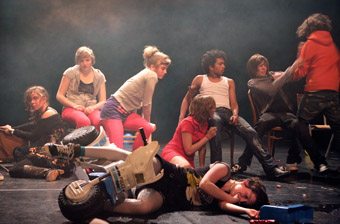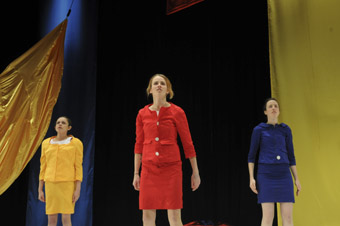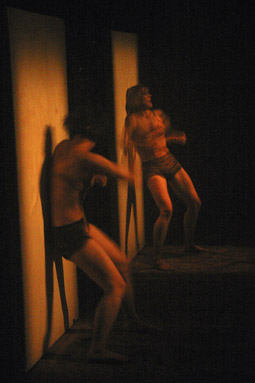signatures and signalling
john bailey: performance at arts house, melbourne

Once and for all we’re gonna tell you who we are so shut up and listen
photo Phile Deprez
Once and for all we’re gonna tell you who we are so shut up and listen
A SIGNATURE’S A FUNNY THING: A SIGN THAT CREATES ITS OWN CREATOR. A UNIQUE MARK THAT PRODUCES THE UNIQUE IDENTITY OF ITS MAKER. I HAVE AN AWFUL SIGNATURE WHICH HAS OCCASIONED LAUGHTER OR SUSPICION FROM COUNTLESS SHOP ASSISTANTS AND OFFICIALS. IT’S AS IF MY OWN SELFHOOD IS DESTABILISED BY THE ERRATIC NATURE OF MY JOHN HANCOCK. BUT WHAT ABOUT THE SIGNATURES OF ARTISTS OVER TIME? A DISTINCTIVE STYLE IS A SALEABLE COMMODITY IN THE VISUAL ARTS, ITS COUNTERFEITING SOMETIMES AMOUNTING TO A CRIMINAL ACT. IN THE PERFORMING ARTS IT’S EVEN MORE COMPLEX.
These thoughts were buzzing around my mind while watching Strangeland, the recent collaboration between Melbourne’s Not Yet It’s Difficult and Korea’s Wuturi. It began as murky light began to filter through the thickest haze effect I’ve ever seen on a stage. Indistinct figures seemed to coalesce and disperse somewhere in the autumnally tinted fog. Their skin was dirty, dusty, perhaps ash-covered. The apparitions seemed revenants haunting us from some unimaginable other-space.
Then I saw the walls. Padded panels a little larger than a door. And I thought, “I wonder when the performers will begin throwing themselves against ‘em?” See, these same panels featured in at least two previous NYID works, and the act of slamming into them has become a kind of signature move for the company. But what does that mean?
On one hand, it could be read as an impoverished recycling of earlier ideas. On the other, it could be a gesture of continuity, tracing a thread that acknowledges the genealogy of artistic production. If you’ve a third hand free, you could also see it as a specifically visceral act of communication, whose violence is more immediate than any of these more linguistic notions can encapsulate.

Post, Shamelessly Glitzy Work
photo Heidrun Löhr
Post, Shamelessly Glitzy Work
A contrasting example. The much lauded trio Post’s Shamelessly Glitzy Work bears distinct connections to their previous body of work. An ironic spectacular featuring ditzy dialogue, alcopop-guzzling, bad dancing, bold colours and an existential emptiness, it’s live art that doesn’t specifically quote but certainly echoes the company’s existing oeuvre. Moreover, these signatures don’t just produce the creative identity that is “Post” but also align the company with others working in a similar vein, such as The Fondue Set and My Darling Patricia. These repetitions create that larger identity often called, for want of a better term, a scene.
Forced Entertainment’s Spectacular played in the same space as Shamelessly Glitzy Work, and its empty hour of anti-theatre, in which a performer apologises at length for the lack of a show, was certainly reminiscent of the company’s extensive body of work. Marie-Anne Mancio, in RealTime 89 [page 34] wrote that “the absent show in Spectacular is also the ghost of shows past…Despite the humour, it’s relentless. Not even painful. Just boring.”
It was pretty boring. The ideas Spectacular raises have been explored to more thought-provoking effect by this same company before. It’s not just the repetition that’s the problem, though. Forced Entertainment have their signature, and it’s one that has deservedly influenced many who have come afterwards. It’s that, in this case, the signature is all that there is. It’s like an autograph on a blank page, whose only value is in the confirmation of an identity, not its creation.
Another perspective. Umberto Eco has written of the process of ostention, of communication in which a mimed action takes the place of words—placing a finger to your lips (shhh), waving a packet of cigarettes (want one?). Ostention isn’t just a fancy form of theatre’s ‘show, don’t tell’ dictum (itself rather dodgy). In ostentive gestures, an action becomes a sign of a sign. Post dramatic theatre often requires an implicit recognition of this slippery form of signification—Spectacular, for instance, is at a surface level all tell and no show, but this itself is what constitutes the work’s expressed meaning.
But as I’ve said, I found it pretty boring. The absent show has itself become a presence in contemporary theatre, and has been invoked to greater effect by others (and by Forced Entertainment, for that matter). Shamelessly Glitzy Work, meanwhile, pokes at the dead remains of dramatic performance with a very big stick that is itself hugely entertaining. Spectacular features interminable death scenes and drawn-out monologues on nothingness; Post play with similar durational concepts through a long, numbing techno dance sequence, and toy with the vacuity of theatre by producing hilarious magic or special effects that express, well, nothing much.

Strangeland, NYID
photo Guiman Shin
Strangeland, NYID
Back to Strangeland. All show and no tell. Movements as signs which seem only to refer to other movements as signs, an infinite regress. Its roots are in dance, yes, and so elements of that vocabulary can be expected to feature, just as Spectacular’s mostly verbal nature appeals to a shared oral vocabulary. But Strangeland, sadly, replaces ‘heard it all before’ with ‘seen it all before.’ Beyond the familiar wall impacts, the choreography of the piece often focused on the kind of shuffling, jerky, unconscious motion that has featured prominently in Melbourne dance for more than a decade, and which has taken on a certain historic air. The interaction between dancers appeared to be based on tiny, improvised movements which occurred whenever another performer was heard to move somewhere nearby. This conjured an interesting sensation of watching the impenetrable communication between ants or other complex social organisms, but is again overly familiar in an age where Merce Cunningham or Deborah Hay have made such processes a common mode of practice.
Post take the familiar and invest it with a surprising currency. In common with Forced Entertainment and NYID, the company holds up to scrutiny the things in which we can no longer place a naïve faith, the world and its forms of representation which have failed us. But rather than the post-apocalyptic void of Strangeland or the ‘sorry about that’ shrug of Spectacular, Shamelessly Glitzy Work makes the shared experience of art a thing of joy in itself. It recovers dead or discredited modes of entertainment with a kind of winking knowingness that is terribly generous to its audience. It knows that we know it all, so it doesn’t need to tell us anything. We get the signs and we get their eternally self-referential status and by gosh, let’s blow up a massive patchwork balloon while we’re thinking about that.
All three works were presented by Arts House over several weeks in a program with new work by locals Panther and The Suitcase Royale. The sixth in the series deserves special mention: Belgian company Ontroerend Goed’s quite incredible Once and for all we’re gonna tell you who we are so shut up and listen. Thirteen teens played out a short chaotic scene structured around simultaneous activities of teendom—teasing scuffles, moody exchanges, boredom, solitude, experimentation. This scene was then repeated with fascinating variations: in an affectionate, euphoric manner; drugged up and stumbling; even, at one point, entirely absent from the stage as their props continue to repeat the scene despite their disappearance.
This work could easily have been a condescending glance backward, either treating teenagers as exotic specimens from another world or using them to remind us of a nostalgic youth we all apparently shared. Instead, it allows its performers to exist on their own terms, as individuals, as a group, as able performers and as fallible humans. They do not become signs of a generation, nor of an abstract principle. The work is carefully constructed, allowing for gloriously open play within its confines, and the energy transfer between audience and stage is of an infectious vivacity that few productions even think to aspire to, let alone achieve.
Not Yet It’s Difficult/Wuturi, Strangeland, director David Pledger, performers Todd MacDonald, Ingrid Weisfelt, Vincent Crowley, Sara Black, Seo Sang Won, Song In Sung, Sang-A Kong, lighting Paul Jackson, Niklas Panjanti, Arts House, Meat Market. Aug 5-8; Post, Shamelessly Glitzy Work, created and performed by Mish Grigor, Natalie Rose, Zoe Coombs Marr, North Melbourne Town Hall, Aug 13-15; Forced Entertainment, Spectacular, director Tim Etchells, performers Claire Marshall, Robin Arthur, North Melbourne Town Hall Aug 6-8; Ontroerend Goed, Once and for all we’re gonna tell you who we are so shut up and listen, writers Joeri Smet, Alexander Devriendt, director Alexander Devriendt, Meat Market, Melbourne, Aug 6 – 11
RealTime issue #93 Oct-Nov 2009 pg. 40






